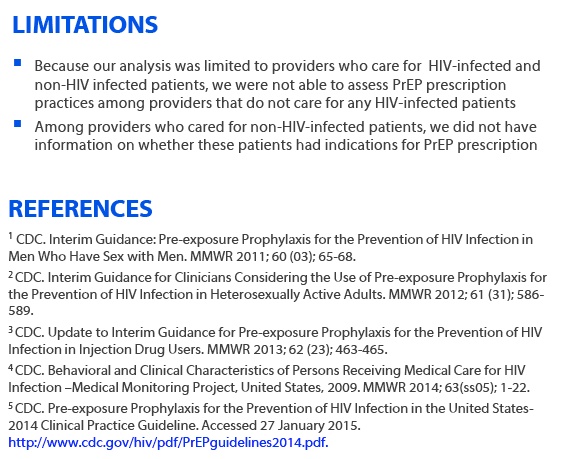 |
 |
 |
| |
Provider Prescription of Pre-Exposure Prophylaxis (PrEP) for HIV Infection
|
| |
| |
Reported by Jules Levin
CROI 2015
Feb 23-26, Seattle, WA
Shikha Garg; John Weiser; Linda Beer; Jacek Skarbinski for the Medical Monitoring Project; Centers for Disease Control and Prevention, Atlanta, GA



program abstract
Background: PrEP with daily oral fixed-dose combination tenofovir/emtricitabine is safe and effective in reducing the risk of HIV acquisition. While official PrEP guidelines were only released in 2014, interim guidance for use of PrEP in certain high-risk groups has been available since 2011. Data on provider uptake of interim PrEP guidance are lacking.
Methods: U.S. care providers were surveyed during June 2013-January 2014 to estimate the weighted prevalence of ever prescribing PrEP and to describe patients for whom PrEP was prescribed. Physicians, nurse practitioners, or physician assistants who had completed training and who provided care to HIV-infected patients were eligible for the survey. We used prevalence ratios (aPR) estimated from multivariable logistic regression to investigate the association between provider characteristics, including demographic factors and HIV care experience, and PrEP prescription. Analyses accounted for clustering, unequal selection probabilities, and non-response.
Results: Surveys were completed by 1234 of 2023 eligible providers (adjusted response rate 64%). Among HIV care providers who responded to questions about PrEP prescription and who also reported providing care to HIV-infected and non-HIV-infected patients (n=935), 26% (95% confidence interval: 20-31) ever prescribed PrEP. Among providers prescribing PrEP, 74% prescribed to men who have sex with men, 23% to men who have sex with women, 30% to women who have sex with men, 23% to uninfected partners in serodiscordant couples trying to conceive, and 1% to injection drug users. Providing direct and continuous care to greater than 50 HIV-infected patients, male gender and gay/lesbian/bisexual orientation were all provider characteristics independently associated with PrEP prescription (Table).
Conclusions: PrEP is a powerful HIV prevention tool, yet at baseline, only one-fourth of U.S. providers who care for both HIV-infected and non-HIV-infected patients reported ever prescribing PrEP based on interim guidance. Although provider uptake may increase with the release of formal PrEP guidance in 2014, targeted efforts should be made to increase PrEP prescription by providers who care for few or no HIV-infected patients and who may have limited experience prescribing antiretroviral therapy.





http://www.cdc.gov/hiv/pdf/PrEPguidelines2014.pdf.
|
| |
|
 |
 |
|
|